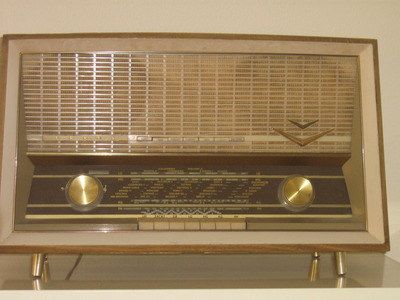

This Erres radio does not work well, the main problem is the switch contacts. It was built in 1962 and its FM range is 87-100MHz, so it misses a large part of the FM band. When it was made, the FM band in Europe was still restricted to 100MHz.
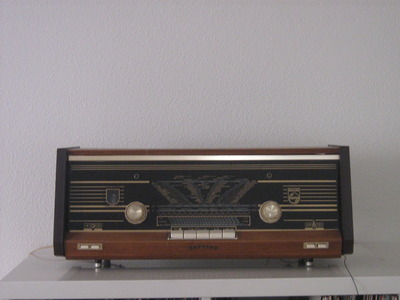
This Philips radio works rather well on FM and reasonably on the mediumwave band. It was built around 1965 and its FM range is 87.5-108MHz, the complete FM band. Many later radios still had an FM range limited to 104MHz.
When those tube radios were new or when they would be restored to like-new condition, they can have excellent performance on mediumwave. Nothing on earth came closer to heaven than tuning over the mediumwave band on a nice winter evening. In the 1980s most European countries still had their main public radio stations on mediumwave. At night, especially in winter, one could hear a station on nearly every channel across the band. Stations from many, many European countries could be heard. You could hear music that was never played on the Dutch radio and was not available in any record store in the Netherlands. Some radios had a rotatable ferrite antenna, so you did not have to rotate the entire radio for optimum reception. On some channels one could hear two different stations (separate from each other) depending on the orientation of the ferrite antenna.
Nowadays many stations have left the mediumwave (and longwave) band and there is more interference. There is only one Dutch public radio station left on mediumwave, the frequencies of the other two are now used by religious stations. Still, listening to the mediumwave band can be a quite enjoyable experience. My portable Sony performs quite well on mediumwave, but it lacks the warm tube sound.

The Sangean WR-1 does not have tubes either, but its sound certainly has more body, even though it is slightly too bassy for my taste. It feels really solid, it is well-built and it is a full analog design. It is my only analog radio that is not at least 40 years old, in fact it is completely new. Sensitivity and selectivity on mediumwave and FM are quite good, but those of the Sony ICF-SW7600GR are still slightly better om mediumwave, on FM the WR-1 takes the lead. The WR-1 is a mono-only receiver, so it can have a narrower IF filter than the Sony (which can receive stereo over headphones). But when I have to find a station on a crowded band using an analog dial, I realize that digital readout does have its merits.
During the early 1980s the situation on FM was rather well-organized. All regular stations were in the 87.5-100MHz range, so they could still be received on very old radios. The FM band was already extended, but the extra part was not used yet. There were no local stations and no commercial stations, so the number of official FM transmitters was much lower than today. On a good radio you could hear Belgian and German stations in a large part of the Netherlands (I could sometimes pick up the BBC on a portable without an outdoor antenna). This is impossible now. The part of the band between 100 and 108MHz was used by pirate stations. Many of those pirate stations were hobbyists playing a certain genre of low quality Dutch language songs. In the part of the band below 87.5MHz (most radios could tune slightly below the low end of the band) you could hear police communication. A scanner was a much better way to hear this communication, but some of it could be heard on any old FM radio.
Both tube radios shown on this page have a single shortwave range from 5.9 to 18MHz, which covers all broadcast bands from 16m to 49m. There's something magical about the experience of tuning over the shortwave band on such a radio, the broadcast bands being like islands crowded with stations, the space between them being the sea, where weird sounds could be heard occasionally. Finding a desired station is like finding a needle in a haystack though.
Over the years I have owned several shortwave receivers, some portables and some communications receivers, like the Racal RA17L, which weighed around 30kg.
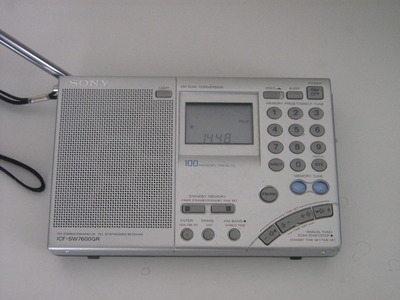
Nowadays one of my shortwave receivers is the Sony ICF-SW7600GR. It covers the entire range from 150kHz to 30MHz plus the extended FM band from 76 to 108MHz. As far as compact portable receivers go, this one has decent performance. It has a synchronous detector and it can receive SSB as well. Of course it is not a real communications receiver. Because I live in an apartment, I am not allowed to have an outdoor antenna. A professional communications receiver without a decent antenna is an expensive way of not being able to receive many stations. That's why I don't own an AR7030 or NRD545 (or a nice transceiver, as I do have an amateur license).
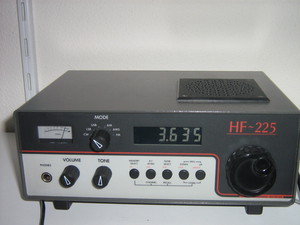
Yet I do own a communications receiver, the Lowe HF225. It has lots of IF bandwidths and it has a real tuning knob (and a real S-meter too). It is a very nice radio to listen to the amateur bands on shortwave, even though it only picks up the stronger stations that manage to get over the S9 local interference. I definitely need to try this thing on a location with a better antenna and less local interference. It does not have all the goodies of a real professional communications receiver, such as passband tuning, a notch filter and switchable AGC timing. But it has very smooth tuning on SSB, better than anything I owned before and better than anything I could buy new for a similar price. It covers the entire range from 30kHz to 30MHz.
I can still listen to air traffic control, radio amateurs and an occasional taxi. Apart from that, it also covers the FM broadcast band and even 27MHz CB.
Around 2006 they started to use some VHF frequencies (148-149MHz, 153-154MHz, formerly used for the first mobile phone network) for church radio, so people who are not able to attend church can still hear the mass. Originally it was planned that these people could buy or rent a special-purpose receiver, but just around that time analog police communications ceased and many, many scanners were discarded. What would be cheaper?

This is my Realistic PRO-2006 scanner. It covers 25-520MHz and 780-1300MHz, so it leaves out a large chunk of the UHF TV band. As we do not have any analog TV transmitters anymore. this range would no longer be useful anyway. It can receive AM, narrow band FM and wide band FM, it has 400 channels in 10 banks and it has 10 search ranges.
It is successful in countries like the UK and Denmark, but it is a complete failure in many other countries, hence the acronym also reads as Dead And Buried. In the Netherlands it is rather close to the Failure end of the spectrum.
The Netherlands had some test transmissions during the 1990s. In 2004 DAB got a second start. All national public radio stations appeared on a DAB multiplex and they started to roll out transmitters until 50% of the country (70% of the population) was covered. But then they completely stopped and for the next 5 years no new DAB transmitters were put on the air. They did license some DAB frequencies to commercial parties, but it is completely unclear what will happen to them and when. There is a new audio codec for DAB (DAB+, using the AAC codec). If we do not use it, we will be stuck with lousy audio quality forever, if we do use it, all existing DAB radios will be obsolete, so their owners will never purchase a digital radio for the foreseeable future. Some European countries seriously plan to switch off analog FM by 2015, but the Netherlands will not be one of them.

I own two DAB radios and there's only one place near the window of my apartment that has usable reception. FM reception on this radio is less than perfect. If you switch it off, it continues to use power in standby mode, probably lots of it. Therefore I disconnect all my radios when not in use.
BBC and Deutsche Welle joined forces to run a single English language DRM network on shortwave. It uses quite a few transmitter locations across Europe, so it should be receivable throughout the day. Even though they spent millions on transmitters, indoor reception is not free of interruptions on my DRM radio during most times of the day. When analog radio reception suffers from interference, you can at least hear something and understand the entire conversation if you care to listen. Not so with DRM. When I'm on holiday, the typical hotel room will not be a more favorable shortwave reception environment than my home, so there.
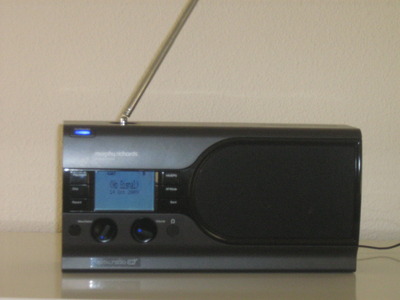
I do own a DRM radio, the Morphy Richards 27024. This radio also picks up analog long, medium and shortwave stations, FM an DAB. Even though the radio has lots of nice features (it can record radio shows on SD cards) and it does work, it does not make me like DRM any better. Especially it does not make me want to throw the Sony into the dustbin. Some reasons for this:
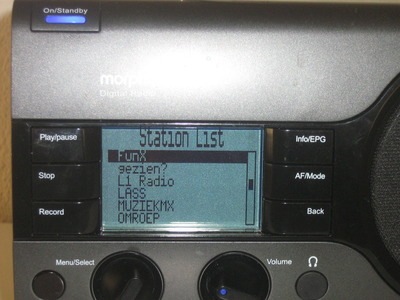
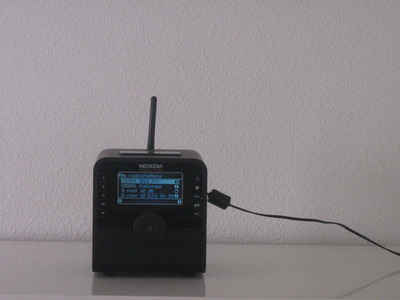
You can even tune to the shortwave amateur bands on the Internet. See the Web-SDR at the University of Twente. This site requires Java.
Compared to regular radio there are some disadvantages: